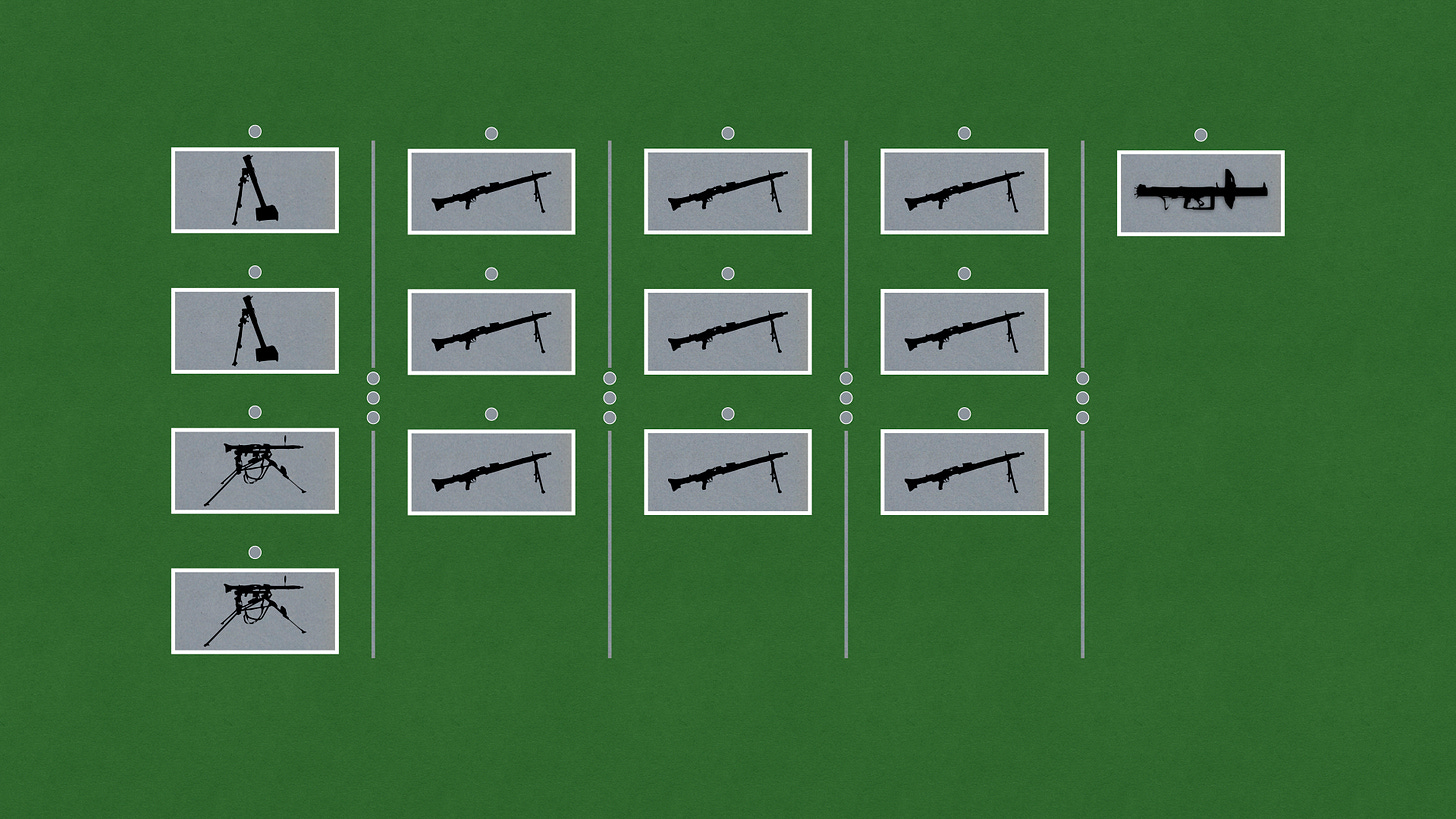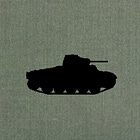Battle Basics for the Leader of a Motorized Infantry Company
Newsletter for Armored Troops
Originally published in the summer of 1944, this article sheds a great deal of light on the sort of problems faced by many small unit commanders during the last year of the Second World War.
1. If you command the lead company don’t push your own point [platoon] too far forward and don’t make it, through the attachment of anti-tank and other heavy weapons, into an independent battle unit. If you do that, it will, in case of contact with the enemy, have to fight alone.
Hold the company, above all the heavy weapons, in such a manner so you can attack quickly and effectively. The earlier that you can do this, the greater the number of heavy weapons that you bring, the fewer casualties your point platoon will suffer.
Commentary. Rather than attaching your company’s heavy weapons to your point platoon, use them to overwatch its movement. Also, keep the rest of your company in within supporting distance. After all, which is stronger, a platoon reinforced with elements of its mother company or a platoon supported by a full company?
2. On the battlefield you can never be strong enough. Don’t begin with a little and make unsuccessful attempts - they only cost blood. Presume that the enemy is twice as strong as you suppose, and attack him with the entire company rather than dribbling on him with platoons. The more you throw at the enemy, the fewer will be your casualties.
You yourself must be far forward when you want to really lead. You are never permitted, however, to run forward of your first echelon. You would make things easier for enemy snipers but harder for your company, because they cannot fight without a leader.
3. The success of an attack is, to a great degree, dependent upon proper use of terrain. It is less a matter of the small distance over which you must attack as how close you can get to the enemy by means of a covered route. Therefore, in your decision, be guided by the position of the assault and fire element.
Commentary: Note how the use of infiltration is not a “special case.” It is part and parcel of every assault.
4. The most important thing for every attack, however, is the overwhelming power with which you attack from the direction from where the enemy least expects your attack. What do you gain from a comfortable trip over so-called favorable terrain for the attack, when your company is shot to pieces? You must attack with understanding. When you stubbornly run up against an obstacle like a bull, then you will get a bloody head.
Work rather with wire cutters, bayonets, and pocket knives through a thicket, wade through a swamp or swim through a river, and when everything is so exhausting and uncomfortable and the water is so cold, attack the enemy where he least expects it.
If surprise succeeds, you can take the enemy from the flank or rear. The enemy is always vulnerable on his flanks. There you can, with numerically weaker forces, annihilate him. Then you have success and have saved lives. “Blood is worth more than sweat!”
5. In every move, your aim must be to hide your intention from the enemy. This includes the setting of the time [for an attack.] Don’t always begin attacks at dawn, when the enemy expects them. Attack, rather, at unusual times - for example, during what hunters call “lazy times” (between 9 and 11 A.M.) or in the afternoon, during the distribution of rations.
It is also not true, that at night, for example, the Russian is superior to our soldiers. At night, the attacker is always superior! Operations at night are very successful and end with surprisingly light losses.
6. Take care, however, that the surprise not be spoiled by a lack of troops. When you assemble or move into the last covered position you must not be noticed by the enemy. Moreover, your heavy weapons moving into particularly favorable firing positions easily betray your plan.
In the jumping off positions and in the movement into these [jumping off positions], particularly at night, external quiet must dominate. Unneeded words, signals, and smoke cost blood.
If you believe, that the enemy has learned your intentions, you must mislead him by only feigning with weak forces supported by the fire element, in order to simultaneously attack him at another location (for example a flank), with the assault element.
“Tying down the enemy from the front with fire and weak forces in order to attack him in the flank with the mass of combat power in the flank and thereby to annihilate him,” is one of the oldest fundamentals of combat, that you can safely use every time.
7. While attacking in unfavorable terrain or along obstacles you must protect your own flanks. Echelon your flank guard somewhat ahead and put the flank guard platoon in woods or the flank guard squad in a creek-bed, so that they can dominate the fields of fire of hidden enemy weapons before the latter can have an effect on the flanks [of your main body].
You must make your men cautious in front of the edges of woods and similar features; for if you go away from cover [of the woods] you will be shot up and your flank will be unprotected.
Commentary. Note the “backwards thinking” here. The attacker should look at the terrain from the defender’s point of view. He should look for places where the enemy ought to have put his weapons. Once these are identified, the attacker can detail weapons to cover these positions. In this way, if those weapons open up, they can be quickly silenced.
8. Never let your infantry go forward into the attack without covering fire from your heavy weapons. On the other hand, never open fire with heavy weapons without making use of it by exploiting with your infantry. “No movement without fire, no fire without movement.”
In addition, you must make use of the fire protection of the heavy infantry weapons of other units, artillery, and aviation by immediate movement of the company. Bombs and shells can often neutralize the enemy. Rarely, however, can they annihilate. Therefore, you must, while the enemy is covered with fire, cross the dangerous area, so that you might be able to break into his position, before he is able once more to raise his head.
Always take the initiative yourself. Don’t hold back only because your neighbor fails to go forward. Someone must start. Why shouldn’t it be you?
Commentary: The concept at work here is less a matter of fires supporting the movement of infantry, but of infantry exploiting the effects of fires, whatever their source.
9. You need expose yourself to the direct fire of the enemy only when you are moving forward. If the attack and, as a consequence, your movement comes to a halt and your companies lie in terrain without cover, you must immediately, without waiting for a command from higher authority, move into the nearest cover or dig yourself in.
This trouble is always well worth the effort. If you give the command when the enemy has already shot you up, it is too late. Moving back is, at that point, too hasty, and costs more blood than staying where you are.
10. In close terrain, for example, in villages or woods or in fighting in enemy trenches, the danger of dispersion and breaking down into small units is especially great, the cohesion and cooperation of the company is particularly important. No squad should enter a house, without being overwatched by another. No fire team should disappear into a thicket without the observation and support of another and no man should jump into a position without being protected by another, in particular supported by a machine gun. In these matters, slack and unsure leadership causes casualties.
11. To fulfill your mission (Auftrag), you must hold your company firmly in your hand, maintain security, and establish its defensive power as quickly as possible. Only undisciplined companies, led by irresponsible leaders, run after loot, take breakfast breaks, or begin to take their clothes off in order to wash something and, in consequence, are surprised and ripped apart by an enemy counter-attack, which will always succeed when one doesn’t prepare for it. Discipline was not instituted for barracks and billets, but for battle!
Notes and Sources:
The paragraphs in plain text provide a verbatim translation of “Battle Basics for the Leader of a Motorized Infantry Company, Part II: Attack” [“Kampfgrundsätze für den Führer einer Panzer-Grenadier-Kompanie (mot.), Folge 2: Angriff”] Armored Troops Newsletter, [Nachrichtenblatt der Panzertruppen] Number 13 (July 1944) US National Archives, Microfilm Publication T-78, Roll 623. A copy of the original article can be found at the Military Learning Library.
The material in italic type was added by the translator.
The information used to create the organizational infographic comes from the much more detailed diagram of the organization of a motorized infantry company [Grenadierkompanie (mot)] in accordance with the War Establishment 1114 of 1 November 1943 [K.St.N.1114 (1.11.1943)] found in the splendid website World War II Day-by-Day.
For Further Reading:






Bruce this is amazing!! Thank you for this resource!!